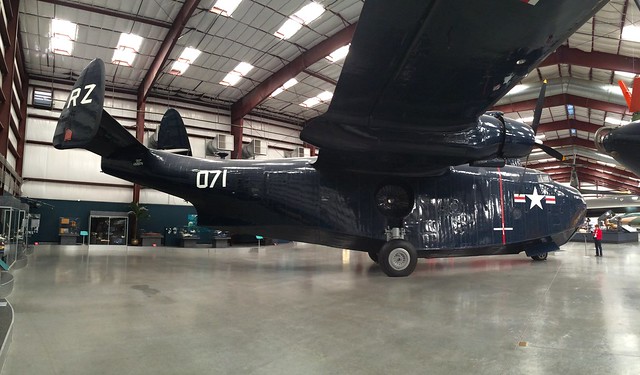Pima Air & Space Museum is determined to keep me on my toes. PASM is closing the normal entrance area for a month, and guests will now be entering the main hangar from the gift shop. Before, my walking tour started underneath the replica of the Wright Flyer. Now it’ll start smack in the middle of the seaplane exhibit.
Like all the other docents, I had a regular thing going, moving from aircraft to aircraft in a counter-clockwise direction around the inside of the hangar. Now I’ll be starting on the other side of the hangar, leading my guests in a clockwise direction. This is most irregular. Not only will I be tripping over my own feet, who knows what garbled version of the facts will come out of my mouth?
Oh well, I’ll have to get used to it … and since tomorrow’s tour starts in the seaplane section, I may as well tell museum guests about biggest thing in there, the Martin PBM-5A Mariner.
Our Mariner (which actually belongs to the Smithsonian and is on loan to us) is the last one left of over 1,300 built. Produced between 1939 and 1949, the Mariner was originally intended to replace the Navy’s obsolete PBY Catalina seaplane. It entered US Navy service in 1940 but didn’t fully replace the Catalina until near the end of WWII. The Navy continued to use the Mariner as a long-range patrol bomber, anti-submarine, and rescue aircraft through the end of the Korean War, retiring its last Mariner in 1958. Other users included the US Coast Guard, the UK, Australia, The Netherlands, Argentina, and Uruguay, which retired the last active-duty Mariner in the early 1960s.
This is a beast of a seaplane. Depending on configuration, it carried 7 to 12 crewmembers and could haul more than 10,000 pounds of cargo, flying 2,400 miles at 200 mph. WWII versions were heavily armed, with fore and aft gun turrets and waist guns (you can see the gun turrets in the photo below). It could carry up to 4,000 pounds of bombs or depth charges, or two Mk 13 torpedoes, in bays incorporated into the engine nacelles aft of the two 2,100 hp radial engines. During WWII, Mariner crews were credited with 10 U-boat kills.
Early versions of the PBM were pure flying boats, which is to say they did not have landing gear and could only be operated from water. The -5A version of the Mariner, or which 36 were built, added retractable landing gear, making it the largest amphibian ever built (yes, there were larger flying boats, but the Mariner was the largest amphibian).
Our PBM-5A was flown by the US Navy from 1948 to 1956. The museum restored it with the colors and markings it wore when it flew for Transport Squadron 21 (VR-21) in the early 1950s.
While ours is the last surviving example out of the water, there’s another one resting upside down under 80 feet of water in Lake Washington near Seattle, where it sank in 1949. The Navy has made two attempts to salvage this aircraft, resulting in the death of one diver and the partial destruction of the airframe. Today it is a training site for divers. Another Mariner is alleged to have exploded in midair in the Bermuda Triangle in 1945, during the famous search for the missing Navy Avengers of Flight 19. One crashed on Mount Tamalpais north of San Francisco in 1944. At least some military PBMs were converted to civilian use, because in 1958 a passenger-carrying version flying for Aero-Topográfica from Lisbon to Maderia disappeared and no trace of it has ever been found. As many as 11 Mariners are said to be sunk in the waters around Kwajalein Island, many of them intentionally scuttled at the end of WWII. The rest of the Mariners? There are probably traces of them in the aluminum pots and pans in your kitchen cupboard.
Thus endeth the lesson. Now I’m ready to talk about the Mariner, and I thank you for letting me use you as a sounding board.
Links:
* Linked site mistakenly refers to the Lake Washington Mariner as a Mars. The Mars was a larger, four-engined flying boat, also produced by Martin.


Please keep the aviation history coming. Your articles are fascinating. So great to get this kind of stuff from a real expert.